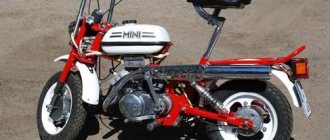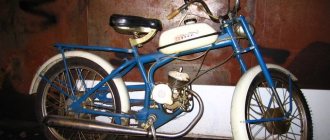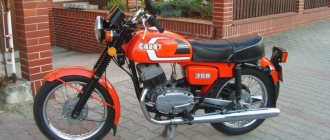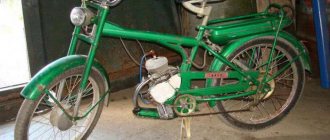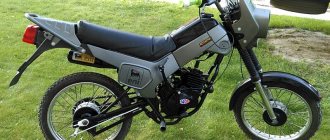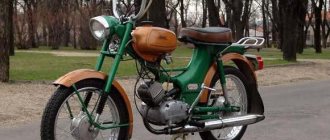It was a revolutionary idea: to make a small, lightweight moped. The strange thing about this idea is that all over the world such a moped was made immediately after the war, when the economy was booming and people could already afford something more expensive than a bicycle. In the Soviet Union, these times came in 1982. Well, or people are simply desperate to wait. Although, like all consumer goods, mokik was produced not because of demand, but because of a plan. The Riga plant had previously produced bicycles with motors, proudly called mopeds, but Riga 26, due to its unusual design or compactness, surpassed all previous versions in terms of the number of mopeds sold.
Minimokic Riga 26
Specifications
As already mentioned, the moped weighs 50 kg. The equipment can move freely with a load of up to 100 kg. The wheelbase is 1000 mm. The dimensions of "Riga" are as follows: length - 1510 mm; The height and width of the model depends on the position of the steering wheel (un/folded). Thus, the width can be 740 mm or 350 mm; height 1000 or 520 mm. Ground clearance: 120 mm. The engine is a carburetor two-stroke power unit in two modifications V50 or M 501. The power is 1.8 hp. Cylinder displacement 49.8 cc. The transmission is available in two modifications, depending on the engine type. The main difference was the speed switch (foot/hand). It is also necessary to say about one cylinder, the diameter of which is 38 mm and the piston stroke is 44 mm. You can start the engine using a kick starter. The ignition is electronic and non-contact. Fuel supply system - carburetor, type K-60V. The fuel tank capacity is 5.5 liters. The exhaust gas exhaust system was presented in the form of a muffler.
Tourist on a moped
In the 70s of the last century, as a teenager, like many of my peers, I dreamed of something more serious than a bicycle - a motorbike or a motorcycle. The dream came true - in 1975, after graduating from the 9th grade, he got a job as a loader in a grocery store during the summer holidays and earned money for a moped. I bought a brand new Riga-7 for 112 rubles in the Moscow Kovrovets store. Now this store no longer exists... I rode on the Riga for two seasons, and then “life took a turn” - going to college, studying, working...
Now there is more free time. In the fall of 2008, he “reanimated” the moped by installing on it the so-called “Chinese dash” that had just appeared in Russian stores in those years. Correctly, this engine is called F-50 and is a further development of the model range of Soviet D-4 - D-8 engines for bicycles and light mopeds. I don’t know whether the Chinese bought a license to produce any D-series engine or simply copied many of its components, but, for example, they say that the clutch basket from the F-50 can be installed on the D-6 without any problems and vice versa. However, the F-50 also has significant differences from the Soviet “dashka”. Chinese engineers abandoned the spool valve in the gas distribution system. Engine displacement increased to 48 cubic meters. cm compared to 45 cc. cm at D-4 – D-8. The power also became higher - 1.6 hp. (1.2 kW). The F-50 has a very simple and reliable electronic ignition. It should also be noted that the F-50 was sold at a very attractive price. In 2008, when I bought an engine, or rather a kit for installing a bicycle, it cost me 4,500 rubles. The kit included the engine itself, a muffler, cables and control handles, a gas tank, a driven sprocket, fasteners, in short, everything necessary to install the F-50 on a bicycle. Now in Russia, even more stores (usually online stores) sell the F-50 at prices of 4,500 - 6,500 rubles per set. A modification of this engine with a larger cubic capacity, the F-80, has also gone on sale. It costs a little more.
But let's get back to my moped. Thanks to the almost identical dimensions of the F-50 and D-6, the Chinese engine fit into the Riga-7 frame without any problems.
The experience of operating the F-50 pleased me. The moped with a Chinese engine accelerated to 50 km/h and maintained a cruising speed of about 42 - 44 km/h. Without the help of pedals, it was possible to overcome inclines of up to 10 degrees. Probably someone reading these lines will wince - “slow mover”, “toy”. Yes, of course, it’s a slow-moving vehicle, but we’re talking about a cheap light moped, and not a liter sportbike. And where I got to on this “toy” is described in the “motorcycle rides” thread. And also, regarding the speed characteristics of my moped, I note that according to the documents, the maximum design speed of the Riga-7 with the original D-6 engine was 40 km/h. So the maximum speed of the moped after installing the Chinese “heart” is not very significant, but that’s all have improved. In addition, the F-50 has proven to be a very reliable engine. It worked stably, started without problems even at low subzero temperatures (minus 2 – minus 4 degrees Celsius). And I have never driven at lower temperatures.
It would seem that everything is fine, having a reliable engine, ride and be happy. But, like an itch in my hands, I wanted the engine to become at least a little more powerful. The first thing that came to mind was to install a spark plug with a longer skirt and, by reducing the volume of the combustion chamber, slightly increase the compression ratio. All my friends who had any knowledge of internal combustion engines dissuaded me from this step. They unanimously argued that the extra turns of the spark plug threads would become overgrown with carbon deposits, after which it would be impossible to unscrew the spark plug from the cylinder head without damaging the head threads. Despite such persuasion, I got an NGK 5111 BP7HS spark plug, and removed the extra one and a half turns of thread on the spark plug skirt with the help of a turner I knew. In the photo on the left is a “standard” F-50 spark plug, on the right – with an extended skirt after 3000 km.
With the new spark plug, the maximum speed increased slightly and the moped began to take off faster. Regarding carbon deposits, the photo shows that there is a certain amount of light brown carbon only on the electrodes and the lower part of the skirt. There is practically no carbon deposits on the side surface of the spark plug (where the thread was removed by a turner).
After changing the spark plug I decided to work on the muffler. The standard muffler, which ended near the pedal carriage, sprayed oil onto the shoes and rear wheel. In addition, as many F-50 owners have noted, the standard muffler strongly “chokes” the engine. Therefore, instead of the standard muffler, a “cigar” from a Soviet two-speed moped was installed.
The gas vent problem has been resolved. The shoes and rear tires stopped getting dirty with oil. It was more difficult with the power characteristics of the engine. The thrust “at the bottom” has increased somewhat. The maximum speed turned out to be slightly higher than with a standard muffler, but lower than if you drive with a half-open muffler hanging on the heels. (I had this happen once when the gasket between the muffler pipe and the cylinder burned out). And yet, problems arose with stable engine operation at idle speed. The engine still started normally, but if you sharply release the gas while driving and disengage the clutch, the engine could stall. The idea arose that when the speed drops sharply, the air filter is filled with a flammable mixture. Therefore, a homemade intermediate pipe was installed between the carburetor and the air filter.
The unpleasant phenomenon disappeared, the engine stopped stalling when the speed was reduced. And, besides, it somehow began to respond more quickly to the throttle.
I inserted a spike of 18 LEDs into the headlight of the moped. Power is supplied from three AA batteries. Such a headlight does not illuminate the road very well, but still makes the moped more visible in the flow of vehicles.
The moped is equipped with an electric bicycle horn.
It works from a button on the gas handle.
By clicking this link: video
you can see how my moped rides.
Breakdowns. During the first 4,000 kilometers (for a light moped this is not so little!) only two trivial breakdowns occurred. After approximately 500 km, the standard gasket between the muffler and cylinder flanges burned out. The issue was resolved with the help of paronite and high-temperature sealant. And, after about 3500 km, the clutch cable tore out of the tip. Such, if I may say so, “problems” are easily solved with the help of improvised means. So I fixed the cable with a screw and nut and continued moving.
After about 4500 km, I replaced the chain and both sprockets. It could still be used, but the wear was already noticeable.
After 4700 km the NGK spark plug failed. Replaced.
The original tires, produced in 1975, lasted about 5,000 km. As soon as I saw that the cord was starting to deteriorate, I replaced it.
So far, I regard all the breakdowns that have occurred as insignificant. The same goes for replacing worn parts (sprockets, chain, tires). I continue to drive.
Happy motorcycling to everyone!
Appearance of "Riga-Mini"
The appearance of the moped is quite simple. At that time, small-capacity models differed little from each other; the model range of Riga mopeds was very similar. But, in this case, the main difference between “Riga” was its dimensions. Due to this, the model was quite popular. A headlight was installed in front, which ensures driving in the dark. There are fenders at the back and front that prevent dust and rainwater from getting on the driver and the motor. Behind the roomy driver's seat is a “modest” trunk, immediately behind which is a brake light. As mentioned earlier, the steering wheel and seat are adjustable. That is, the ability to “tailor” the equipment individually to each person makes the model very universal.
A lot of criticism was directed towards the Riga's handling. In particular, many were not satisfied with the tires, which were very hard. If they were damaged or punctured, it was very difficult to determine this. That is, the movement was carried out on an empty wheel. Due to the small size of the wheels, when they fell into a hole, the discs were often deformed. Therefore, many people preferred the Verkhovyna moped, whose technical characteristics were close to the Riga, but the wheels were still larger.
Riga 26 today
Although there are still clubs, or even sects of lovers of the Siauliai motor. Checkers can be tuned on the knee. And that's very cool. Technical creativity allows you to improve your overall technical culture. Today you can still find these mopeds in barns and dachas. Restoring a rarity in its original form may be complicated by the fact that the sale of spare parts is not established and will need to be collected from the world piece by piece. Although motors of modern modifications produced by Red October or imported manufacturers will allow you to make a unique toy and put the designer on the move.
Mokik Riga 26, modern tuning
Unfortunately, the sale of these wonderful mopeds is a thing of the past. But, if you set a goal, through the barns, through the bottom of the barrel, you can find crumbs of the past and restore what was unjustly forgotten and disdainfully thrown into the far corner of the garden. It’s hard to believe, but there were years when WLA military Harleys were scrapped, not realizing that their value years later would be much higher than forty kopecks per kilogram. There is confidence that the Riga 26 Mini moped will eventually become as valuable a rarity as the Honda MonkeyZ50 of the first years of production with a similar chassis configuration.
